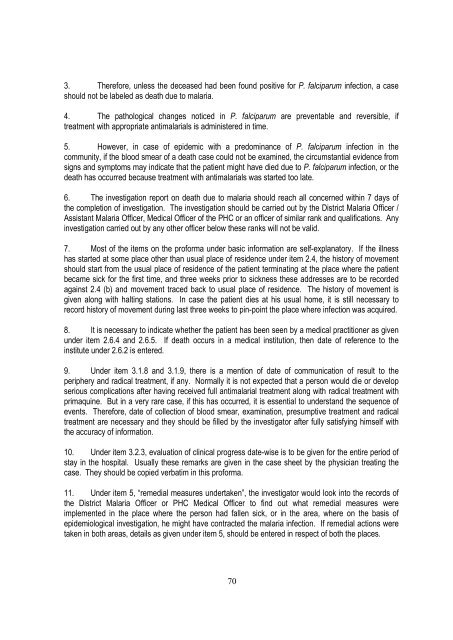training module for medical officers primary health centre - NVBDCP
training module for medical officers primary health centre - NVBDCP
training module for medical officers primary health centre - NVBDCP
- No tags were found...
You also want an ePaper? Increase the reach of your titles
YUMPU automatically turns print PDFs into web optimized ePapers that Google loves.
3. There<strong>for</strong>e, unless the deceased had been found positive <strong>for</strong> P. falciparum infection, a caseshould not be labeled as death due to malaria.4. The pathological changes noticed in P. falciparum are preventable and reversible, iftreatment with appropriate antimalarials is administered in time.5. However, in case of epidemic with a predominance of P. falciparum infection in thecommunity, if the blood smear of a death case could not be examined, the circumstantial evidence fromsigns and symptoms may indicate that the patient might have died due to P. falciparum infection, or thedeath has occurred because treatment with antimalarials was started too late.6. The investigation report on death due to malaria should reach all concerned within 7 days ofthe completion of investigation. The investigation should be carried out by the District Malaria Officer /Assistant Malaria Officer, Medical Officer of the PHC or an officer of similar rank and qualifications. Anyinvestigation carried out by any other officer below these ranks will not be valid.7. Most of the items on the pro<strong>for</strong>ma under basic in<strong>for</strong>mation are self-explanatory. If the illnesshas started at some place other than usual place of residence under item 2.4, the history of movementshould start from the usual place of residence of the patient terminating at the place where the patientbecame sick <strong>for</strong> the first time, and three weeks prior to sickness these addresses are to be recordedagainst 2.4 (b) and movement traced back to usual place of residence. The history of movement isgiven along with halting stations. In case the patient dies at his usual home, it is still necessary torecord history of movement during last three weeks to pin-point the place where infection was acquired.8. It is necessary to indicate whether the patient has been seen by a <strong>medical</strong> practitioner as givenunder item 2.6.4 and 2.6.5. If death occurs in a <strong>medical</strong> institution, then date of reference to theinstitute under 2.6.2 is entered.9. Under item 3.1.8 and 3.1.9, there is a mention of date of communication of result to theperiphery and radical treatment, if any. Normally it is not expected that a person would die or developserious complications after having received full antimalarial treatment along with radical treatment withprimaquine. But in a very rare case, if this has occurred, it is essential to understand the sequence ofevents. There<strong>for</strong>e, date of collection of blood smear, examination, presumptive treatment and radicaltreatment are necessary and they should be filled by the investigator after fully satisfying himself withthe accuracy of in<strong>for</strong>mation.10. Under item 3.2.3, evaluation of clinical progress date-wise is to be given <strong>for</strong> the entire period ofstay in the hospital. Usually these remarks are given in the case sheet by the physician treating thecase. They should be copied verbatim in this pro<strong>for</strong>ma.11. Under item 5, “remedial measures undertaken”, the investigator would look into the records ofthe District Malaria Officer or PHC Medical Officer to find out what remedial measures wereimplemented in the place where the person had fallen sick, or in the area, where on the basis ofepidemiological investigation, he might have contracted the malaria infection. If remedial actions weretaken in both areas, details as given under item 5, should be entered in respect of both the places.70
















